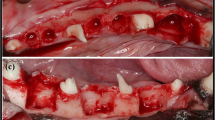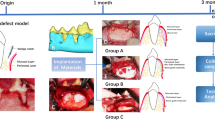Abstract
Background
The use of the autogenous periosteal graft as biological barrier has been proposed for periodontal regeneration. The aim of this study was to evaluate the histometric findings of the subepithelial connective tissue graft as barrier in intrabony defects compared to a bioabsorbable membrane.
Methods
Three-walled intrabony defects were created surgically in the mesial aspect of the right and left maxillary canines in five healthy mongrel dogs. The defects were chronified, and two types of barriers were randomly carried out for guided tissue regeneration in a split-mouth design: the test group with a subepithelial connective tissue graft and the control group with a bioabsorbable membrane. The specimens were processed for histometric analyses of the epithelium (E), connective tissue (CT), newly formed cementum (NC), new bone (NB), and total newly formed tissues (NFT).
Results
The test side showed smaller mean of NC (3.6 ± 1.2), NB (2.1 ± 0.7), and NFT (7.7 ± 0.8) than the control group (NC 7.3 ± 0.5; NB 5.3 ± 1.3; NFT 10.1 ± 2.2; P < 0.05). No statistically significant differences were verified for E (test 3.1 ± 2.0; control 2.8 ± 2.1; P > 0.05) and CT (test 2.5 ± 1.1; control 2.0 ± 0.5; P > 0.05) between groups.
Conclusion
The bioabsorbable membrane was more effective in maintaining the space for periodontal regeneration than periosteal connective graft when used as barrier.
Clinical relevance
The bioabsorbable membrane showed more favorable regenerative results in intrabony defects in dogs than the subepithelial connective tissue graft as biological barrier.






Similar content being viewed by others
References
Nyman S, Gottlow J, Karring T, Lindhe J (1982) The regenerative potential of the periodontal ligament. An experimental study in monkeys. J Clin Periodontol 9:257–265
American Academy of Periodontology (2005) Position paper: periodontal regeneration. J Periodontol 76:1601–1622
Murphy KG, Gunsolley JC (2003) Guided tissue regeneration for the treatment of periodontal intrabony and furcation defects: a systematic review. Ann Periodontol 8:266–302
Kinaia BM, Steiger J, Neely AL, Shah M, Bhola M (2011) Treatment of class II molar furcation involvement: meta-analyses of reentry results. J Periodontol 82:413–428
Cortellini P, Pini PG, Tonetti M (1995) Periodontal regeneration human infrabony defects with titanium reinforced membranes. A controlled clinical trial. J Periodontol 66:797–803
Cortellini P, Pini PG, Tonetti M (1996) Periodontal regeneration of human infrabony defects with bioreaborblabe membranes. A controlled clinical trial. J Periodontol 67:217–223
Tonetti M, Pini-Prato G, Cortellini P (1996) Guided tissue regeneration of deep intrabony defects in strategically important prosthetic abutments. Int J Periodontics Restorative Dent 16:378–387
Hürzeler MB, Quiñones CR, Caffesse RG, Schüpbach P, Morrison EC (1997) Guided periodontal tissue regeneration in interproximal intrabony defects following treatment with a synthetic bioabsorbable barrier. J Periodontol 68:489–497
Camargo PM, Lekovic V, Weinlaender M, Vasilic N, Madzarevic M, Kenney EB (2002) Platelet-rich plasma and bovine porous bone mineral combined with guided tissue regeneration in the treatment of intrabony defects in humans. J Periodontal Res 37:300–306
Onodera H, Shibukawa Y, Sugito H, Ota M, Yamada S (2005) Periodontal regeneration in intrabony defects after application of enamel matrix proteins with guided tissue regeneration: an experimental study in dogs. Biomed Res 26:69–77
Camargo PM, Lekovic V, Weinlaender M, Divnic-Resnik T, Pavlovic M, Kenney EB (2009) A surgical reentry study on the influence of platelet-rich plasma in enhancing the regenerative effects of bovine porous bone mineral and guided tissue regeneration in the treatment of intrabony defects in humans. J Periodontol 80:915–923
Corinaldesi G, Lizio G, Badiali G, Morselli-Labate AM, Marchetti C (2011) Treatment of intrabony defects after impacted mandibular third molar remval with bioabsorbable and non-resorbable membranes. J Periodontol 82:1404–1413
Siciliano VI, Andreuccetti G, Siciliano AL, Blasi A, Sculean A, Salvi GE (2011) Clinical outcomes after treatment of non-contained intrabony defects with enamel matrix derivate or guided tissue regeneration: a 12-month randomized controlled clinical trial. J Periodontol 82:62–71
Stavropoulos A, Chiantella G, Costa D, Steigmann M, Windisch P, Sculean A (2011) Clinical and histologic evaluation of a granular bovine bone biomaterial used as an adjunct to GTR with a bioresorbable bovine pericardium collagen membrane in the treatment of intrabony defects. J Periodontol 82:462–470
Sculean A, Nikolidakis D, Schwarz F (2008) Regeneration of periodontal tissues: combinations of barrier membranes and grafting materials – biological foundation and preclinical evidence. A systematic review. J Clin Periodontol 35:106–116
Lekovic V, Kenney EB, Carranza FA, Martignoni M (1991) The use of autogenous periosteal grafts as barriers for the treatment of class II furcation: involvements in lower molars. J Periodontol 61:775–780
Bouchard P, Ouhayoun JP, Nilvéus RE (1993) Expanded polytetrafluoroethylene membranes and connective tissue grafts support bone regeneration for closing mandibular Class II furcations. J Periodontol 64:1193–1198
Lekovic V, Klokkevold PR, Camargo PM, Kenney EB, Nedic M, Weinlaender M (1998) Evaluation of periosteal membranes and coronally positioned flaps in the treatment of class II furcation defects: a comparative clinical study in humans. J Periodontol 69:1050–1055
Belal MH, Al-Noamany FA, El-Tonsy MM, El-Guindy HM, Ishikawa I (2005) Treatment of human class II furcation defects using connective tissue grafts, bioabsorbable membrane, and resorbable hydroxylapatite: a comparative study. J Int Acad Periodontol 7:114–128
Deo VDS, Bhongade ML (2008) An evaluation of the effectiveness of connective tissue grafts as a barrier with bioresorbable collagen membrane in the treatment of mandibular Class II furcation defects in humans: a case report series of 20 cases. PERIO-Periodontal Practice Today 5:281–290
Kwan SK, Lekovic V, Camargo PM, Klokkevold PR, Kenney EB, Nedic M et al (1998) The use of autogenous periosteal grafts as barriers for the treatment of intrabony defects in humans. J Periodontol 69:1203–1209
Nelson SW (2001) Subperiosteal connective tissue grafts for pocket reduction and preservation of gingival esthetics: a case report. J Periodontol 72:1092–1099
Nelson SW (2001) Subperiosteal and intraosseus connective tissue grafts for pocket reduction: a 9–13 year retrospective case series report. J Periodontol 72:1424–1435
Gamal AY, Mailhot JM (2008) A novel marginal periosteal pedicle graft as an autogenous guided tissue membrane for the treatment of intrabony periodontal defects. J Int Acad Periodontol 10:106–117
Gamal AY, Attia-Zouair MG, El-Shall OS, Khedr MMF, El-Farag MA, Mailhot JM (2010) Clinical re-entry and histologic evaluation of periodontal intrabony defects following the use of marginal periosteal pedicle graft as an autogenous guided tissue membrane. J Int Acad Periodontol 12(3):76–89
Paolantonio M, Femminella B, Coppolino E, Sammartino G, D’Arcangelo C, Perfetti G, Perinetti G (2010) Autogenous periosteal barrier membranes and bone grafts in the treatment of periodontal intrabony defects of single-rooted teeth: a 12-month reentry randomized controlled clinical trial. J Periodontol 81:1587–1595
Gamal AY, El-Shal OS, El-Aasara MM, Fakhry EM (2011) Platelet-derived growth factor-BB release profile in gingival crevicular fluid after use of marginal periosteal pedicle graft as an autogenous guided tissue membrane to treat localized intrabony defects. J Periodontol 82:272–280
Singhal R, Nandlal KA, Rastogi P (2013) Role of space provision in regeneration of localized two-wall intrabony defects using periosteal pedicle graft as an autogenous guided tissue membrane. J Periodontol 84:316–324
Ishida H, Tamai S, Yajima H, Inoue K, Ohgushi H, Dohi Y (1996) Histologic and biochemical analysis of osteogenic capacity of vascularized periosteum. Plast Reconstr Surg 97:512–518
Lindhe J, Pontoriero R, Berglundh T, Araujo M (1995) The effect of flap management and bioresorbable occlusive devices in GTR treatment of degree III furcation defects. An experimental study in dogs. J Clin Periodontol 22:276–283
Wiltfang J, Merten HA, Peters JH (1998) Comparative study of guided bone regeneration using absorbable and permanent barrier membranes: a histological report. Int J Oral Maxillofac Implants 13:416–421
Shirakata Y, Oda S, Kinoshita A, Kikuchi S, Tsuchioka H, Ishikawa I (2002) Histocompatible healing of periodontal defects after application of an injectable calcium phosphate bone cement. A preliminary study in dogs. J Periodontol 73:1043–1053
Hayashi C, Kinoshita A, Oda S, Mizutani K, Shirakata Y, Ishikawa I (2006) Injectable calcium phosphate bone cement provides favorable space and a scaffold for periodontal regeneration in dogs. J Periodontol 77:940–946
Yamada S, Shima N, Kitamura H, Sugito H (2002) Effect of porous xenographic bone graft with collagen barrier membrane on periodontal regeneration. Int J Periodontics Restorative Dent 22:389–397
Tabata M, Shimoda T, Sugihara K, Ogomi D, Ohgushi H, Akashi M (2005) Apatite formed or/in agarose gel as a bone-grafting material in the treatment of periodontal infrabony defects. J Biomed Mater Res B Appl Biomater 75:378–386
Wiskesjö UM, Selvig KA, Zimmerman G, Nilveus R (1991) Periodontal repair in dogs: healing in experimentally created chronic periodontal defects. J Periodontol 62:258–263
Simion M, Dahlin C, Rocchietta I, Stavropoulos A, Sanchez R, Karring T (2007) Vertical ridge augmentation with guided bone regeneration in association with dental implants: an experimental study in dogs. Clin Oral Implants Res 18:86–94
Greenstein G, Greenstein B, Cavallaro J, Tarnow D (2009) The role of bone decortication in enhancing the results of guided bone regeneration: a literature review. J Periodontol 80:175–189
Acknowledgments
The authors would like to thank FAPESP (São Paulo Foundation for the Support of Research, grant no. 03/12810-5) for financial support.
Conflict of interest
The authors declare that they have no conflict of interest.
Author information
Authors and Affiliations
Corresponding author
Rights and permissions
About this article
Cite this article
Ribeiro, F.S., Pontes, A.E.F., Zuza, E.P. et al. Connective tissue graft as a biological barrier for guided tissue regeneration in intrabony defects: a histological study in dogs. Clin Oral Invest 19, 997–1004 (2015). https://doi.org/10.1007/s00784-014-1323-1
Received:
Accepted:
Published:
Issue Date:
DOI: https://doi.org/10.1007/s00784-014-1323-1




